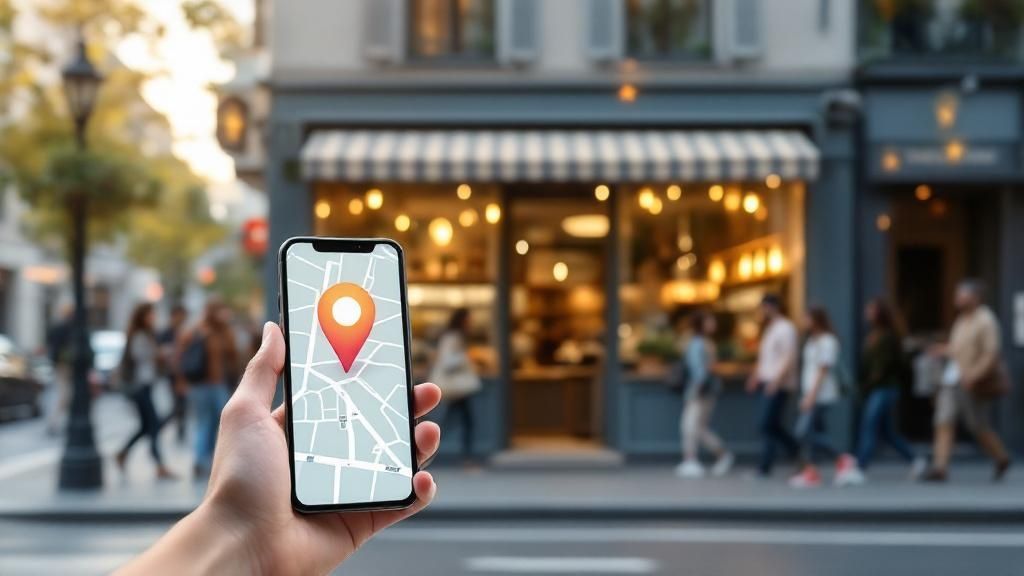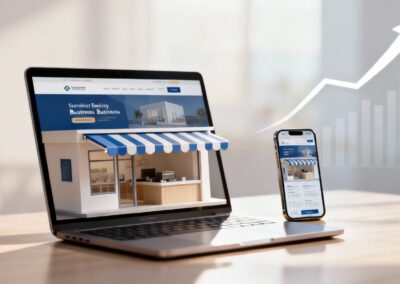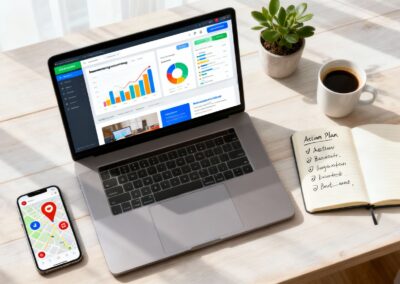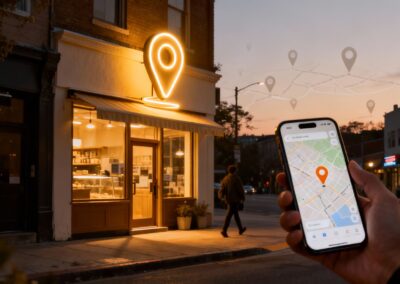When you boil it down, great local SEO is all about making your business the most obvious, trusted choice for people in your area. This means having a rock-solid Google Business Profile, consistent information across online directories, and a healthy flow of glowing customer reviews.
Why Local SEO Is Your Biggest Growth Lever
Let's be honest, local search isn't just another box to check on your marketing to-do list. It’s how people find businesses now. Think about it: when you need a plumber, a great cup of coffee, or a last-minute haircut, what do you do? You pull out your phone and search for something "near me."
That simple action is the modern version of word-of-mouth, creating a direct line from a customer's immediate need straight to your front door.
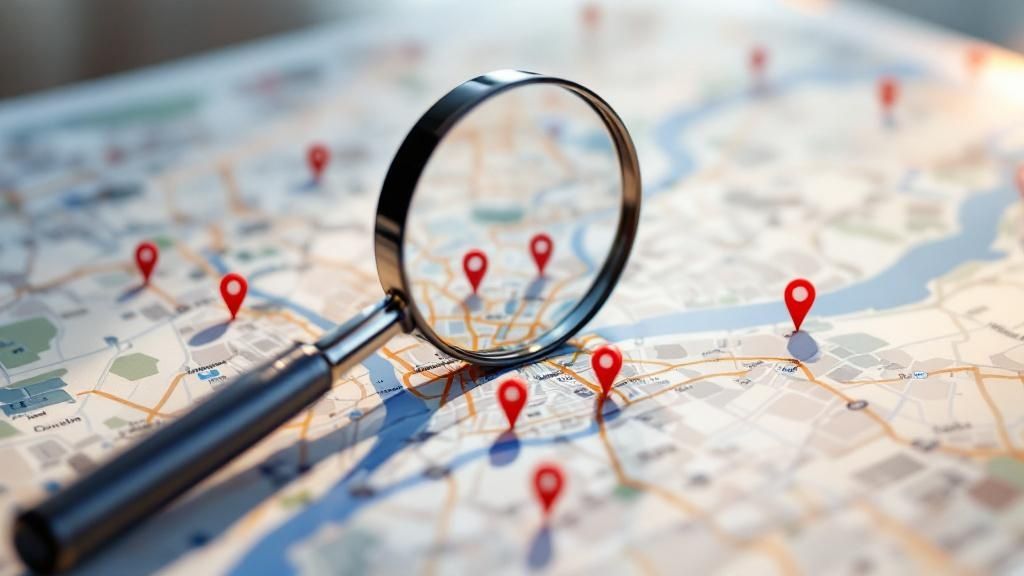
Learning how to improve local SEO isn't about gaming the system. It's about showing up for your customers right when they’re ready to make a decision. The most important thing to remember is that people making local searches are ready to act. They aren't just window shopping; they have a problem and they’re looking for a solution right now.
The Real-World Impact of Local Searches
This isn't just a hunch; the data paints a very clear picture. A massive 46% of all Google searches are from people looking for local information.
Even better, a study found that 78% of local searches on a mobile device lead to an offline purchase, many within just a few hours. This is a huge opportunity for any business that shows up in those local results. You can learn more about local search behavior and how it shapes customer decisions.
Local SEO isn't just about getting found online. It's about being chosen by customers who are in your neighborhood and ready to spend money.
Ultimately, a strong presence in local search brings real, measurable results. We’re talking more foot traffic, more phone calls, and more qualified leads from people who are already nearby. If you ignore local SEO, you’re basically invisible to your most valuable audience. Investing here builds a reliable, powerful growth engine for your business.
Making Your Google Business Profile a Customer Magnet
Think of your Google Business Profile (GBP) as your digital storefront. For local businesses, it’s arguably the single most powerful tool you have. A well-tended profile doesn’t just put you on the map, it actively pulls customers through your door. It’s not about just filling in the blanks; it's about turning your profile into your best salesperson.
The whole process is pretty straightforward: claim and verify your listing, fill out every single detail you can, and then keep the conversation going with your customers.
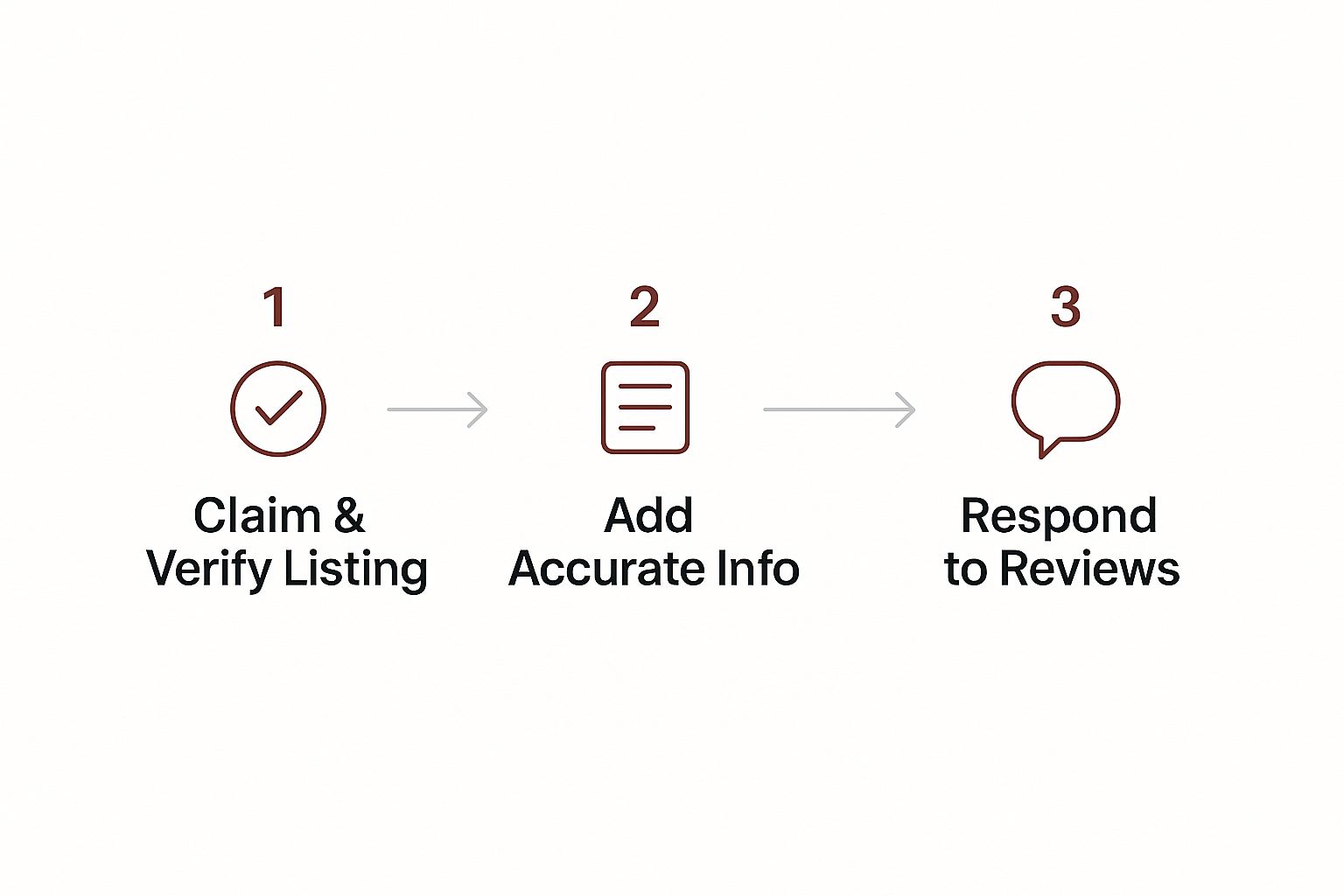
This simple flow of claiming, completing, and communicating is the bedrock of a strong GBP that grabs the attention of local searchers and turns them into actual customers.
Completing Your Profile for Maximum Impact
Every empty section on your GBP is a missed opportunity. I see it all the time: businesses that stop after adding their name, address, and phone number (NAP). You have to go deeper.
It all starts with choosing the most accurate primary category for your business. This one choice has a huge impact on the types of searches you show up for. From there, it's about adding rich, helpful detail:
- Services and Products: List everything you offer, complete with descriptions. If you're a plumber, don't just put "plumbing." Get specific with "drain cleaning," "water heater repair," and "emergency services." This helps you rank for those specific long-tail searches.
- Business Description: This is your chance to tell your story. Write a compelling summary that explains what makes you different. Why should a customer choose you over the competitor down the street?
- High-Quality Photos: Show, don't just tell. Post clear, professional photos of your storefront, your team in action, and finished projects. I’ve seen the data: businesses with photos get way more requests for directions and clicks to their websites. It’s a no-brainer.
To give you a clear roadmap, here’s a quick checklist I use with clients to make sure every critical part of their profile is dialed in.
Google Business Profile Optimization Checklist
This table breaks down the essential tasks for optimizing your GBP and explains why each one is so important for getting seen by local customers.
| GBP Feature | Optimization Action | Why It Matters for Local SEO |
|---|---|---|
| Business Name | Ensure it matches your real-world business name exactly. | Consistency builds trust with Google and customers. Adding keywords is against guidelines and can get you penalized. |
| Primary Category | Select the most specific and accurate category for your main service. | This is the single biggest factor influencing which searches you appear in. Get this right. |
| Services & Products | List every single service or product you offer, with detailed descriptions. | Helps you rank for highly specific "near me" searches and shows customers the full scope of what you do. |
| Business Hours | Keep your regular and holiday hours updated religiously. | Inaccurate hours are a huge source of frustration for customers and can lead to negative reviews. |
| Photos & Videos | Regularly upload high-quality images of your work, team, and location. | Visuals increase engagement, build trust, and can significantly boost clicks and calls from your profile. |
| Google Posts | Create weekly posts about offers, events, or recent projects. | Keeps your profile looking active and fresh, giving customers a reason to check back and engage. |
| Q&A Section | Proactively ask and answer your own frequently asked questions. | Controls the narrative and provides immediate, helpful information, reducing friction for potential customers. |
Following this checklist ensures you're not leaving any opportunities on the table. A fully optimized profile is a magnet for local traffic.
Using GBP Features to Engage Customers
An optimized profile is an active one. You can't just set it and forget it. Google gives you tools to keep your listing fresh and engaging for anyone looking to learn how to improve local seo.
You should be creating Google Posts regularly to announce specials, share company news, or highlight a recent 5-star review. Think of it as a free mini-billboard right on the search results page. And don't sleep on the Q&A section. I always advise clients to add their own common questions and then answer them. It’s a great way to get ahead of customer concerns and show off your expertise.
At the end of the day, this all comes down to visibility in the Google Map Pack. It’s prime real estate, with a staggering 42% of users clicking on one of the top three results. Your GBP is what gets you there, directly influencing 32% of local pack rankings. Remember, your primary business category is the strongest signal you can send.
If you want to truly dominate the Map Pack and turn your GBP into a lead-generating machine, you need to dive into the specific strategies to rank on Google Maps.
Tuning Your Website for Local Search Signals
Your Google Business Profile is the handshake, but your website is where the real conversation happens. It's your job to make sure that conversation screams "local expert" to both Google and your customers. This isn't just about sticking your city name on the homepage and calling it a day.
To really connect with your local market, your website has to feel like it belongs there. This is a critical piece of the local SEO puzzle because it builds immediate trust and relevance.

A simple but non-negotiable starting point is your NAP (Name, Address, Phone number). Get this information on your site, usually in the footer, and make absolutely certain it matches your GBP listing exactly. Any inconsistency, no matter how small, can confuse search engines and hurt your rankings.
Creating Hyper-Local Content
One of the most powerful things you can do is build out dedicated pages for each specific city or neighborhood you serve. Let's say you're a roofer based in Springfield but you regularly work in Greenfield and Shelbyville. Don't just list those towns; create a unique "Roofer in Greenfield" page.
And please, don't just duplicate the content and swap out the city name. That's a rookie mistake. Instead, customize each page with details unique to that location. Mention a well-known local landmark, showcase a project you completed there, or feature a glowing testimonial from a client in that exact town.
A plumber, for instance, could write a blog post titled "Solving Springfield's Hard Water Problems." This kind of content is brilliant for two reasons:
- It hits the exact local search terms your ideal customers are typing into Google.
- It immediately positions you as the go-to expert who truly understands the community's unique needs.
This strategy shows you're an active part of the local scene, not just some faceless business chasing a keyword.
Pro Tip: Embedding an interactive Google Map on your contact page does more than help customers find you. It sends a direct, powerful signal to Google that confirms your physical location, cementing your local authority.
Ultimately, you want a website that feels like it was built for the people in your service area. Write neighborhood guides, post about your team's involvement in a local charity event, or feature other local businesses you partner with. These actions weave your business into the fabric of the community, building customer loyalty and sending powerful local search signals that Google simply can't ignore.
Getting Your Name Out There: Building a Strong Local Footprint
Think of it this way: search engines like Google want to be absolutely sure your business is a real, active part of the local community before they show you to searchers. It's not enough to just say it on your own website. You need other reputable online sources to vouch for you. This is where citations and local links come in; they act as digital votes of confidence.
A citation is just an online mention of your business's Name, Address, and Phone number (NAP). You'll find them in online business directories, on social media, or even in local news articles. There's one golden rule here: consistency. A seemingly tiny difference, like using "St." on one directory and "Street" on another, can muddy the waters for search engines and hurt their trust in your data.
Your business's NAP information needs to be identical everywhere it appears online. Treat it like a digital fingerprint. The clearer and more consistent it is, the easier it is for search engines to verify that you're a legitimate local operation.
Earning Trust with Local Backlinks
Citations are the foundation, but earning local backlinks is how you build real authority. A backlink is simply a link from another website pointing to yours. When a well-regarded local website links to you, it sends a powerful signal to Google that your business is a trusted pillar of the community.
You don't need to get tangled up in complicated link-building campaigns. The best opportunities for local SEO are usually right in your own backyard.
Here are a few practical ideas I've seen work wonders:
- Sponsor a local Little League team or a community 5K. You'll almost always get a link from their sponsors page, which is a fantastic and highly relevant local endorsement.
- Team up with a neighboring business. For example, a wedding photographer could write a guest post for a local venue's blog about the "Top 5 Photo Spots at Our Location."
- Host a charity drive or a free community workshop. Local news sites and community bloggers are constantly looking for feel-good local stories to share.
Each of these isn't just about getting a link. It’s about genuinely embedding your business into the fabric of your town. This creates a powerful web of online trust that search engines notice and reward, ultimately making it much easier for local customers to find you when they need you most.
Turning Customer Reviews into a Ranking Factor
Reviews are the new word-of-mouth. Think about it: they’re one of the first things you look for, and they're a massive trust signal for both potential customers and Google. A steady flow of positive, recent reviews tells search engines you're a legitimate, active business that people like. This directly impacts how you show up in local search results.
So, how do you get more of them? Getting happy customers to leave a review doesn't have to be awkward. Most of the time, all it takes is a simple, well-timed ask.
Right after a successful service call or a happy purchase, send a quick follow-up email or text. The trick is to include a direct link to your Google review page, removing any friction. Make it effortless for them to share their positive experience.
Responding to All Feedback
Your work isn't done when the review comes in. Responding to every single one, good or bad, is essential.
Thanking someone for a positive review is just good manners and shows you appreciate their business. But how you handle negative feedback is what really sets you apart. A professional, non-defensive response demonstrates accountability and can often turn a bad situation around. Remember, your replies are public, and they tell future customers a lot about how you handle things when they don't go perfectly.
For a deeper dive, check out these best practices for online reputation management.
The data doesn't lie. A complete and verified Google Business Profile boosts consumer trust by 2.7 times and is 50% more likely to lead to a purchase. And with 99% of people now using the internet to find local businesses, a strong review profile is non-negotiable if you want to convert those searchers into customers.
Don't see negative feedback as a failure. Treat it like a free business consultation. A thoughtful, calm response can win over more future customers than a dozen five-star reviews ever could. It proves you're a real business that's committed to getting it right.
It's not just about collecting feedback, either. Successful local SEO means you're actively using strategies for managing customer reviews to build your reputation and, in turn, influence your rankings. This kind of active engagement creates a powerful cycle of social proof that fuels your local growth.
Your Questions About Local SEO Answered
Even with a solid game plan, it's completely normal to have questions pop up. Let's dig into some of the most common things business owners ask when they’re trying to get a handle on local SEO.

How Long Does It Take to See Local SEO Results?
This is always the million-dollar question, isn't it? The honest answer is: it depends, but it’s not an overnight fix.
While you might see a quick bump in visibility within a few weeks after fully optimizing your Google Business Profile, real, lasting local SEO is a marathon, not a sprint. You can generally expect to see meaningful movement in your rankings, calls, and foot traffic within 3 to 6 months.
Think of it like building a reputation in your town. It takes time for consistent efforts like earning reviews, building citations, and publishing local content to really stack up and pay off.
What's the Real Difference Between Local and National SEO?
The easiest way to think about it is scope and intent. Traditional SEO casts a huge net, trying to catch attention from a national or even global audience. Local SEO, on the other hand, is all about being the big fish in your small pond.
The goal isn’t to be seen by everyone. It’s to be the go-to choice for customers in your specific service area. It zeroes in on signals like your address, local directory listings, and your prominence in the Google Map Pack to connect you with nearby customers who are ready to buy.
Can I Do Local SEO Without a Physical Storefront?
Absolutely. In fact, local SEO is a lifesaver for service-area businesses like plumbers, home inspectors, mobile detailers, or consultants who meet clients on-site.
You don't need a public-facing shop to dominate local search. In your Google Business Profile, you can simply hide your physical address and define your service area by listing the specific towns, counties, or zip codes you cover. This gets you in front of "near me" searches in all the right places while keeping your home address private.
Ready to stop wondering and start ranking? The team at Digital Lotus Marketing specializes in creating custom local SEO strategies that bring more customers through your door. Let's build your local presence together. https://digitallotusmarketing.com

